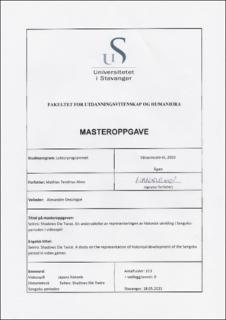| dc.contributor.advisor | Dessingué, Alexandre | |
| dc.contributor.author | Almo, Mathias Tendrius | |
| dc.date.accessioned | 2021-09-03T16:34:03Z | |
| dc.date.available | 2021-09-03T16:34:03Z | |
| dc.date.issued | 2021 | |
| dc.identifier | no.uis:inspera:80599373:9796620 | |
| dc.identifier.uri | https://hdl.handle.net/11250/2773506 | |
| dc.description.abstract | Denne studien undersøker hvordan spillet Sekiro: Shadows Die Twice uttrykker og representerer historisk utvikling i Sengoku-perioden av Japans historie. Undersøkelser av Japans historie i videospill har i lengre tid blitt underrepresentert til fordel for den europeiske historien. Årsaksforklaringer til dette kan være mangfoldige, men denne studien er en begynnelse på arbeidet med å rette fokus mot de mer underrepresenterte narrativ.
For å organisere arbeidet med Sekiro bruker studien metoden kalt HGR-Rammeverket, et verktøy for undersøkelser av relasjonen mellom videospill og historie. Dette bistår i organiseringen av undersøkelsene og gir en lettfattelig oversikt over historien i Sekiro. Studien tar også avstand fra rammeverket ved å se på årsaksforklaringer for hvorfor historien fremstilles slik den gjør. Sekiro drøftes opp mot både historiedidaktiske og semiotiske teorier.
Funnene i studien peker mot at et ekstremt fokus på krig og konflikt dominerer spillet og i tur den historiske representeringen. Funnene peker også mot at historiske elementer hentes og implementeres i spillet basert på om de passer eller ikke. Funnene indikerer at historien blir brukt fleksibelt til å tilpasses et rigid spillsystem, ikke motsatt. Spillsjangeren og Japans litterære tradisjoner kan ilegges en del av forklaringen på dette.
Satt sammen gir studien grobunn for ytterligere undersøkelser rundt representeringen av Japans historie i videospill. Undersøkelsene tilbyr et innblikk på prioriteringer i prosessen av å skape videospill og hvilke valg som er tatt i implementeringen av historie. | |
| dc.description.abstract | This study research how the video game Sekiro: Shadows Die Twice expresses and represents historical development in the Sengoku era of Japanese history. Studies on Japanese history in videogames has for a long time been underrepresented compared to studies of European history in videogames. Reasons for this could be many, but this study is the beginning of the work of focusing on the more underrepresented narratives.
To aid in organizing the work with Sekiro this study uses the method called The HGR-Framework, a tool for investigating the relation between videogames and history. This aids in organizing the research and supplies an easy to understand overview of history in Sekiro. The study also distances itself from the framework by looking at explanations on why history is represented the way it is. Sekiro is being put up against history didactic and semiotic theories.
The findings in this study point towards there being an extreme focus on war and conflict in the game and that this also impacts the historical representation. The findings also points to the selection of historical elements, and how they are implemented in the game, is being based on whether they fit or not. The findings indicate that history is being used flexibly in order to best conform to the rigid game structure, rather than the game structure being modified to best fit history. Both the game genre and Japanese literary traditions could explain some of this prioritization.
Put together the study provides fertile ground for further research into the representation of Japanese history in video games. The research offer an insight into the priorities in the process of creating video games and what choices is being made in the implementation of history. | |
| dc.language | nob | |
| dc.publisher | uis | |
| dc.title | Sekiro: Shadows Die Twice. En undersøkelse av representeringen av historisk utvikling i Sengoku-perioden i videospill | |
| dc.type | Master thesis | |
